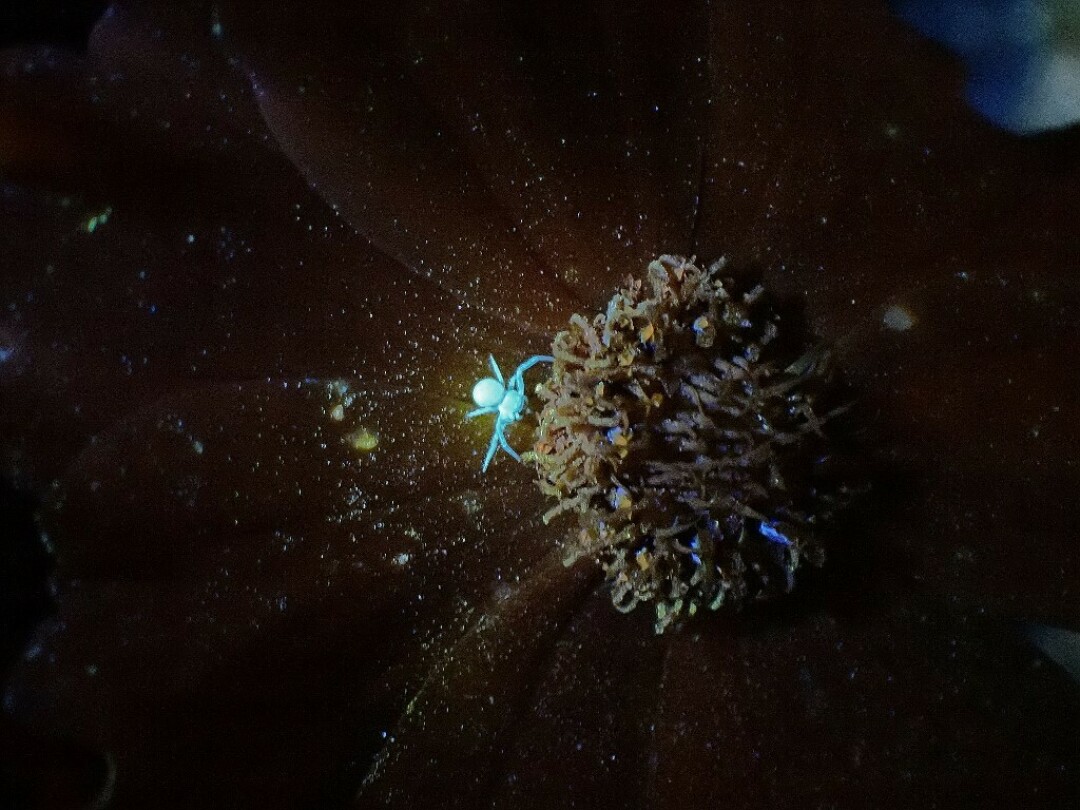The glowing attraction of spiders

The luminous fluorescence of adult female crab spiders attracts more insects to the flowers where they wait in ambush. Photo with 365 nm UV light by Emily Stone.
The muggy air turned cool as darkness fell. Armed with two flashlights and a camera, I crept from the quiet street into the yard and hoped no one would see me. Turning on the bigger of the two flashlights, I swept the beam from side to side. Bright stripes glowed, dark circles sucked in the light, and glitter covered everything.
Illuminated by ultraviolet light, the museum’s pollinator gardens were magical on that July evening in 2021. Juggling my camera, regular flashlight, and UV flashlight, I captured photos of the patterns on flower faces that are usually invisible to human eyes.
While black-eyed Susan petals look yellow in daylight, my UV flashlight revealed a black hole at their center. Impatiens flowers in a pot showed subtle lines that would guide a bee toward nectar. And everywhere, grains of pollen glowed like fairy dust.
Among all these colors and patterns, my eyes kept catching on tiny beings shining like stars. I looked closer. With eight legs and an adorably round thorax each, the luminous spots revealed themselves as crab spiders. I knew that a couple of our local crab spider species camouflage themselves on blossoms by turning yellow or white, and then wait to ambush pollinators.
But fluorescent crab spiders? That was new. I stored away the observation and moved on with a busy summer.
Flash forward to a couple of days ago. I’ve been listening to science writer Ed Young’s new book, Immense World: How Animal Senses Reveal the Hidden Realms Around Us, which just won the 2022 Sigurd Olson Nature Writing Award. In the chapter about sight, Young makes a passing reference to the fact that crab spiders may attract more bees to their flowers by fluorescing in UV light. T
he proverbial lightbulb went off in my head, illuminating memories of my nocturnal foray in the pollinator garden.
With just a little digging, and the help of Google Scholar, I discovered, for starters, that most (or even all?) spider blood fluoresces. It isn’t called blood, though. The technical term is hemolymph. It’s bluish-green in regular light, and sloshes around inside a spider without the constraint of veins.
I wasn’t seeing spider blood in the garden, though. Some spiders use the fluorophores from their blood to make their exoskeleton fluoresce. Since bees and many other insects can see UV light, but don’t necessarily have high visual acuity, the glowing crab spiders seem to appeal to them, and flowers with a crab spider attract more bees than flowers without.
(That particular research was done on crab spiders in Australia, but other studies have found that fluorescence has evolved multiple times in the crab spider family tree, so I’m going to assume that if someone studied our Northwoods crab spiders, they’d find similar trends.)
Spiders further exploit this tactic by making themselves as visible as possible. While we barely see a yellow spider on a yellow flower, some crab spiders choose to sit on a UV-dark part of the flower, so a bee would see a bright spot on a dark background…and mistake it for a nectar guide. Being camouflaged to mammal eyes and highly attractive to insect eyes at the same time is quite a trick!
Not every spider fluoresces on the outside, though. They seem to be able to choose whether or not to let their fluorophores shine through from their hemolymph based on age and sex. Adult male crab spiders don’t fluoresce brightly. They prioritize reproduction over food, and spend most of their time wandering in search of females. They are likely safer being incognito.
Immature crab spiders of both sexes do fluoresce brightly. I saw tons of these tiny ones on flowers in my flashlight beam that night, and knew I could never find them again in daylight. A study from 2017 hypothesized that these small spiders seek out places on flowers where their fluorescence matches the background in order to hide from their UV-focused predators—jumping spiders. Following the original study that Ed Young mentioned in his book, adult female crab spiders are big and bright. They are using their fluorescence to attract the large prey necessary to fuel the production of a large clutch of eggs. There’s more, I’m sure, to be learned about the crab spiders and their glowing blood. For now, I’m thrilled that a single sentence in a book led me to a better understanding of a mystery I’d almost stopped wondering about. Many months after I ventured into that garden with a UV flashlight, it is still illuminating my world. “The majesty of nature is not restricted to canyons and mountains…To perceive the world through other senses is to find splendor in familiarity and the sacred in the mundane. Wonders exist in a backyard garden…” --Ed Yong, An Immense World: How Animal Senses Reveal the Hidden Realms Around Us
Emily M. Stone is Naturalist/Education Director at the Cable Natural History Museum. Her award-winning second book, Natural Connections: Dreaming of an Elfin Skimmer, is now available to purchase at www.cablemuseum.org/books and at your local independent bookstore, too. For more than 50 years, the Cable Natural History Museum has served to connect you to the Northwoods. The Museum is closed for construction of our new exhibit: The Northwoods ROCKS! It will open on May 2, 2023. Follow us on Facebook, Instagram, YouTube, and cablemuseum.org to see what we are up to.
